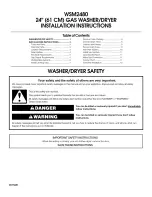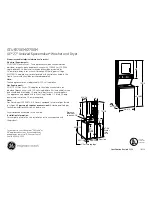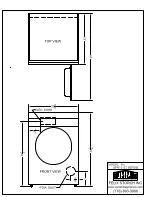
9
Connect the inlet hoses to the washer
IMPORTANT:
Make sure that the flat washers have been placed
into the hose couplings.
H
C
H. Hot water inlet
C. Cold water inlet
1.
Attach the hot water hose to the washer’s hot (H) water inlet
valve. Screw on coupling by hand until it is seated on the
washer.
2.
Attach the cold water hose to the washer’s cold (C) water
faucet. Screw on coupling by hand until it is seated on the
washer.
3.
Using pliers, tighten the couplings with an additional
two-thirds turn.
NOTE:
Do not overtighten. Damage to the coupling can result.
4.
Turn on the water faucets completely and check for leaks.
NOTE:
Replace inlet hoses after 5 years of use to reduce the
risk of hose failure. Record hose installation or replacement
dates on the hoses for future reference.
Periodically inspect and replace hoses if bulges, kinks, cuts,
wear, or leaks are found.
Route the Drain Hose
Proper routing of the drain hose protects your floor from damage
due to water leakage. Read and follow these instructions.
Remove
d
rain hose from the washer
Gently pull the corrugated drain hose from the shipping clips.
Laun
d
ry tu
b
d
rain or stan
d
pipe
d
rain
Connect the drain hose form to the corrugated drain hose.
A
B
A. Snap either end of the drain hose form to the drain hose at the point
where the corrugation begins.
B. Bend drain hose over drain hose form and snap into place.
To keep
d
rain water from going
b
ack into the washer:
■
Do not straighten the drain hose, and do not force excess
drain hose into standpipe. Hose should be secure, but loose
enough to provide a gap for air.
■
Do not lay excess hose on the bottom of the laundry tub.
Floor
d
rain
You may need additional parts. See Floor drain under “Tools and
Parts.”
Secure the Drain Hose
1.
Drape the power cord over the washer top.
2.
Move the washer to its final location.
3.
Place the drain hose in the laundry tub or standpipe as shown.
See illustrations A and B.
A
B
C
4.
If the washer faucets and the drain standpipe are recessed,
put the hooked end of the drain hose in the standpipe as
shown. See illustration C.
NOTES:
■
Do not force excess drain hose back into the rear of the
washer.
■
To avoid siphoning, do not seal or put more than 4½"
(114 mm) of the drain hose into drainpipe or standpipe.
Level the Washer
Properly leveling your washer avoids excessive noise and
vibration.
NOTE:
Installing washer on soft floor surfaces, such as carpets or
surfaces with foam backing, is not recommended.
1.
Slide the washer to its final location.
2.
Check that all four feet are in firm contact with the floor.
Summary of Contents for Duet sport
Page 55: ...55 Notes ...










































